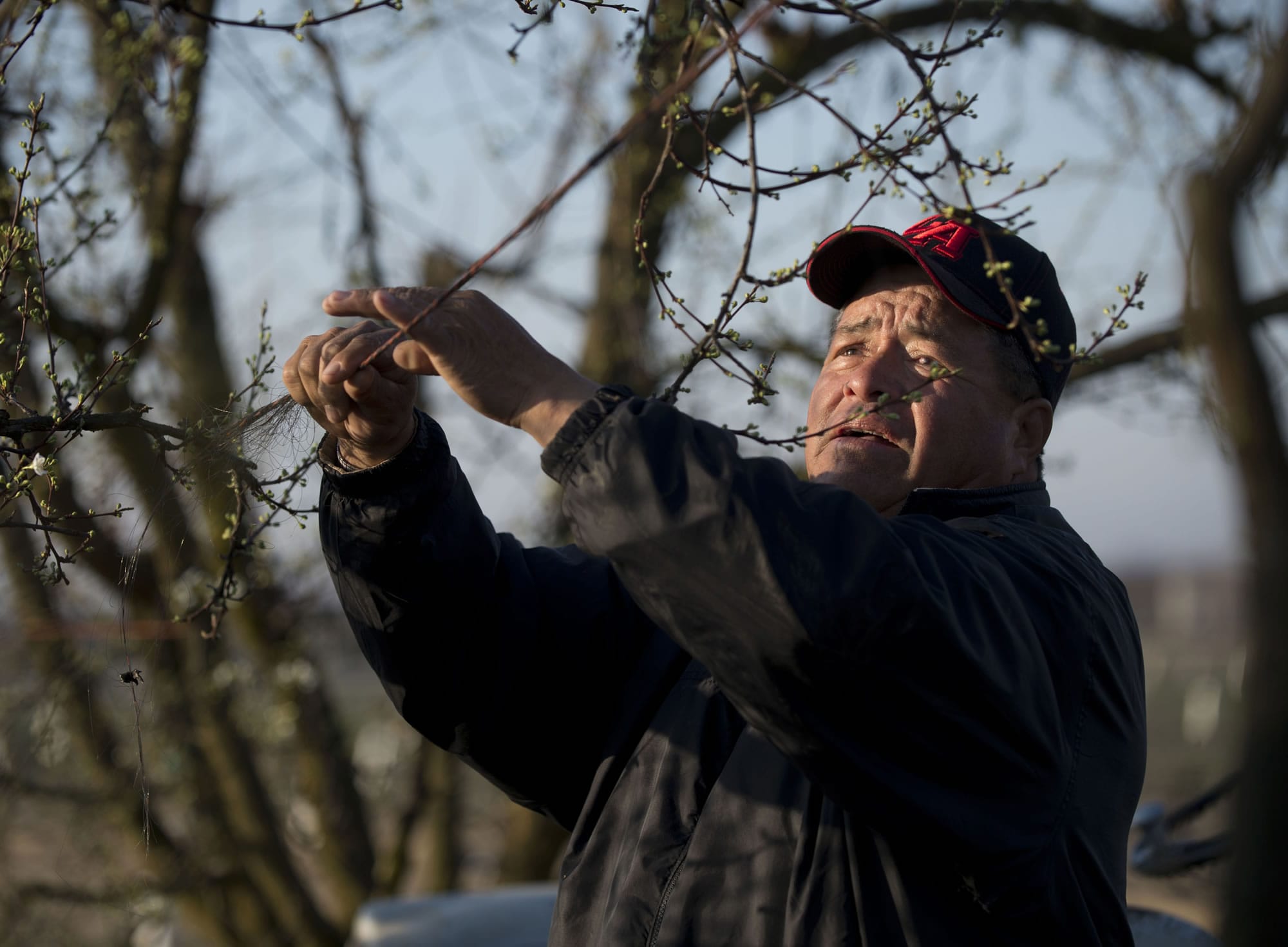SELMA, Calif. — Vicente Contreras is 70 years old — and “no mas,” he insists with a smile — and he says he is still fit and hearty enough to perform the hard labor of California’s farm fields.
Contreras concedes his knees hurt when he climbs ladders to pick peaches, nectarines and plums for $8 to $9 an hour, six days a week, during the peak summer harvest. And during the less rigorous pruning of grapevines in winter, he can’t move as fast as the young workers — at least when they happen to be around.
Amid the verdant fields and orchards of America’s most bountiful agricultural region, California farmworkers are graying. A labor shortage deepens as fewer younger workers arrive from Mexico and more head home to stay.
Increasingly, California’s $44.3 billion agricultural industry must rely on the well-calloused hands of older workers who came many years ago to fill jobs pruning, planting, picking and packing.
These days at Chandler Farms, a fourth-generation family ranch 20 miles south of Fresno, veteran workers like Contreras are in the majority.
On a recent weekday, Antonio Magdaleno, 59, cut grapevines in a neighboring field. Magdaleno emigrated from Michoacan, Mexico, in 1973 and has spent 36 of his last 40 years on Central Valley farms.
His features bronzed and weathered, Magdaleno said he looks forward to the mid-winter pruning, “a beautiful time and something special,” marking the start of the growing season.
“It’s always been us,” Magdaleno said in Spanish. “Time has passed, and we’re older. The young people want to work in factories and other places.”
The aging of California’s agricultural workforce reflects a convergence of trends.
In many cases, the children of farmworkers who arrived decades ago have little interest in field work, leaving much of the vital labor to their elders.
Tighter U.S. immigration enforcement, as well as brutal cartel-driven violence along the Mexican border, have deterred many potential workers from attempting to cross.
And, amid a rebounding economy in Mexico, Mexican farms are facing their own labor shortage and have plenty of work to offer at home.
The upshot, according to the California Farm Bureau Federation, is that more than 70 percent of state agricultural producers anticipate a worker shortage starting this spring and worsening though the growing season. Some officials estimate the labor force could fall by more than 80,000 farmworkers — down from the 450,000 workers on whom farmers have come to rely for the peak harvest of late summer.
“Basically, we’re running out of low-skilled workers. People simply are not doing farm work to the extent they were doing before,” said J. Edward Taylor, a University of California-Davis, economist who has studied the migration of farmworkers from Mexico.
Contreras, the 70-year-old farmhand, says he is happy to be among those still working the orchards and vineyards at Chandler Farms, which produces tree fruit, raisin grapes and almonds.
“What I like is being out with people in the fresh air,” said Contreras in Spanish, his eyes glinting in the crisp morning sun. “I’m alive, active and ready for this work.”
Grinning, he contorted to parody a feeble man shriveling into a ball. “If I don’t work, I’ll do this,” he said.
But from California’s Central Valley to Washington D.C., the graying workforce adds urgency to the debate over immigration reform.
Farm lobbyists and elected officials are discussing remedies that include granting legal status to more than one million undocumented farmworkers in the United States and establishing an expanded guest worker visa program for agriculture to ensure a steady supply of laborers.
“We have to try to find a system that is not going to cause a major disruption to our industry,” said Bryan Little, director of labor affairs for the California Farm Bureau Federation. The industry group favors letting undocumented farmworkers stay in the country while applying for legal status, as well as drawing in seasonal guest workers to replenish the labor force.
California agricultural interests estimate that as many as 70 percent to 90 percent of farmworkers in the state may be here illegally, often presenting counterfeit documents to secure work.
Those who face the least danger of deportation — and who are least likely to flee in immigration raids — tend to be veteran workers, whose U.S. residency is more established.
Bill Chandler, 73, runs the family ranch in Selma with his son, John, who is 35. Chandler says his workforce largely consists of older laborers who got permanent residency or U.S. citizenship under a 1986 immigration reform law signed by President Ronald Reagan.
“There are always people in the ag labor force who don’t have (proper) papers,” Chandler said. “So we’re all scrambling for what labor is here. And they’re older folks.”
He added: “They’re special. They’re really special.”
“It’s very hard to find people who work in the fields whose parents migrated from Mexico to work in the fields,” said Taylor of UC-Davis. “The second generation doesn’t do farm work. That’s why we’ve relied on a steady influx of newcomers. And the newcomers are in dwindling supply.”



